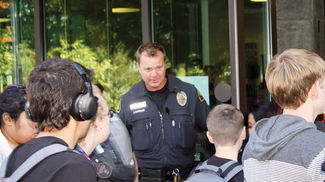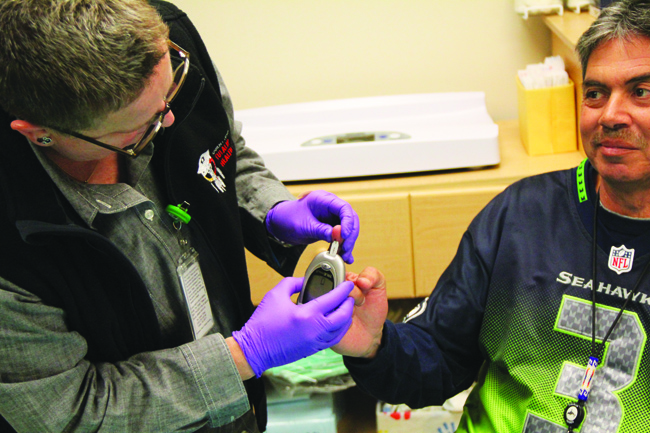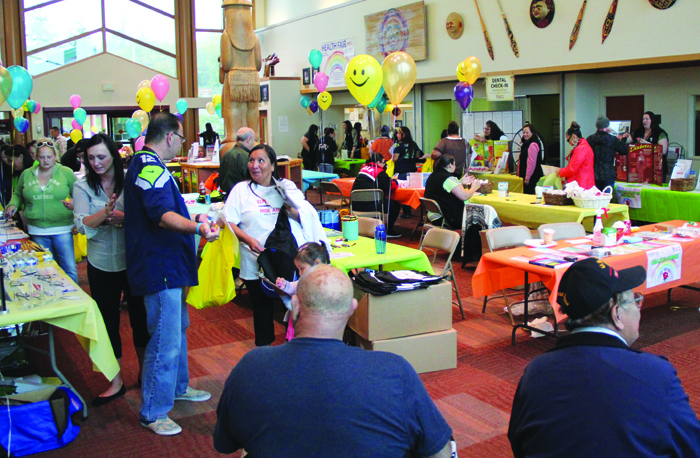Article and photo by Micheal Rios
The Marysville School District (MSD) began a new one-to-one initiative that will span the entire month of October and put a Chromebook computer in the hands of more than 5,500 students in grades 6 through 12. As part of the roll-out, Tulalip Heritage High School was the first school chosen to receive the latest and greatest generation of HP Chromebooks. With the lightning fast Chrome OS, 8-second boot-up time, and over eight hours of battery life, the Chromebooks provide the versatility teachers need and the technology students want.
“We are thrilled about the limitless learning possibilities using Chromebook,” said MSD Superintendent Becky Berg. “With support of our Marysville and Tulalip communities, we are investing in the technological tools of today that will help our students become tomorrow’s leaders. Technology continues to change rapidly. We are equipping our student to be active, contributing citizens in a digital world.”
According to an MSD press release, the devices are fully funded by a technology levy approved by district voters in 2014. Preparations for the Chromebook initiative began with last year’s upgrade of the district’s wireless Internet infrastructure. Since then, MSD partnered with a local Marysville company, Advanced Classroom Technologies, to install more than 60 miles of network cabling. The system went live in March 2015, and now all district facilities have Wi-Fi available to the students and community during non-school hours.
So whether you are at school campus to watch a sporting event, attending an afterhours activity, or just sticking around to do homework or research, you can now connect to a free, public Wi-Fi that becomes available at the end of the school day. This is a huge benefit for students and their fellow community members who don’t have an available internet connection at home.
Students will be allowed to take and use the Chromebook devices at home following the school day and use them on home or public Internet connections. Even if they’re used outside of the district, the devices have built-in content filtering as required by law.
The Chromebooks initiative will change the instructional learning environment for the students at Heritage, while keeping information and their resources constantly up-to-date. Think of how people generally learn new methods and strategies in today’s digital era. We will search Google, Wikipedia or YouTube to learn something in the moment. Moving away from the traditional model of teachers as ‘the fountains of knowledge’, MSD wants the students to be more independent and active in their knowledge development. Students will no longer have to rely necessary on their teacher or an outdated textbook to deliver content anymore. Instead, teachers will be facilitating use of the ever-expanding wealth of knowledge available via Chromebooks.
Scott Beebe, MSD Technology Directory, says 140 teachers received professional development training (e.g. productive internet searching, learning Google Apps, basic troubleshooting) in August on how to use the Chromebooks in the classroom, and about 150 more will be trained throughout the month of October.
The professional development will focus on learning to design lessons that not only empower and engage students in compelling work, but also leverage the power of technology to connect people and ideas.
Heritage students and teachers alike agree the one-to-one Chromebooks initiative benefits everyone. Students are able to do their work more efficiently and have no difficulty submitting assignments with the Google Docs app, while teachers no longer have to try to decipher student handwriting and can edit assignments and provide immediate feedback to students individually.
“The Chromebooks make it easier for us [students] to stay organized and turn our work in on-time,” says Heritage senior Samantha Marteney. “We each have our own computer so it’s easier for us to gather information. For me, it’s way easier to turn in assignment even on days I’m not at school, I can just email them to my teachers.”
“I think the Chomebooks make it a lot easier to take notes in class and complete assignments,” added fellow Heritage senior Mikaylee Pablo. “With the Google Drive app, it saves all our work for us as we type, so we don’t have to worry about losing papers or journals. Plus, I can now do research and type at the same time, instead of doing research on a desktop then writing in a notebook.”
Heritage High School has never had a library or computer lab that is accessible to students furthering their learning like other high schools in the district. The Chromebooks bring a world wide web of books and other resources to their hands now.
“The Chromebooks are a wonderful resource for our students. It’s amazing to see every one of our students with their own computer and now provides them with the opportunity to open doors to learning and enrichment that we’ve never had access to in the past,” explains Heritage humanities teacher Marina Benally. “The Chromebooks bring more of the world into our classes. The access to information makes this a thriving learning community and as such we further and grow each other’s thinking through technology. I’m more and more facilitating rather than being the sage on the stage. It makes education really exciting for our students.”
With such rapid investment in communication devices, wide-scale wireless network, and professional development, student learning is clearly on center stage. The Chromebooks initiative will help students achieve more academically, perform better on tests and be in a better position when it comes to computing in the collaborative online environments of today’s digital era.




















